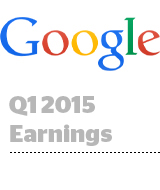Google’s Q1 2015 earnings report continued a trend that’s more than three years old: declining CPC value, offset by the rising number of total paid clicks.
The number of users clicking on a Google ad was up 13% year over year, though analysts were expecting that number to be slightly higher.
Google CFO Patrick Pichette, who will be retiring in a few weeks, started the Thursday afternoon call by announcing, “Google’s first quarter revenue was $17.3 billion, up 12% year over year.” However, Google’s CPC rate declined 7% in the same period.
The stock has trended up in after-hours trading, from around $547 at the closing bell to as high as $567 during the call. Despite that, Google’s Q1 earnings, which were down quarter over quarter almost across the board, are the sixth consecutive quarter where the company missed on expected revenue figures.
Google received questions assuming that the increased user migration to mobile, where ad rates are cheaper than desktop display ads, has been driving down the margins on the company’s ads, but Pichette disputed the theory. “I want to provide more detail, because commenters are incorrectly assuming the problem is monetizing mobile.”
The declining rates should instead be attributed to the rising popularity of YouTube and the TrueView video ad product. Google counts it as a click any time a viewer doesn’t actively choose to skip an ad, which is part of the reason why YouTube ads have lower monetization rates than a click for desktop display ads. Pichette claimed that if you discount TrueView ads, what appear to be negative revenue rates would in fact be “healthy and growing.”
YouTube and TrueView have seen major growth and are poised for a breakout in ad revenue as many in the industry anticipate the value of online video, as well as the value of digital and mobile video ads, to rise alongside consumer adoption.
Thus one of Google’s most promising products, and an emerging staple in their core ad business, is conveniently responsible for some of Google’s more disappointing numbers.
Google CBO Omid Kordestani and Pichette also addressed the elevated importance of the mobile web experience to the company’s business interests. Recent initiatives, such as the change in the company’s algorithm to incorporate a site’s mobile user experience into its display rankings, are widely regarded as a means to accelerate the use and sophistication of the mobile web, which has lagged behind browsing and search within apps like Facebook.
In a veiled allusion to Facebook’s demographic richness, compared to Google’s more intent-based data, Kordestani said that for conversions, “It’s sometimes better to know [the user is] searching for an SUV than the demographics.” By pushing the industry to adopt better, faster web browsing standards (or risk slipping down in the search rankings), Google is enabling itself to increase the share it will have in reaching audiences at moments lower down the sales funnel. “Consumers reach for their phones a lot, and some moments matter more than others,” Kordestani said.
Google also emphasized that their pivot to mobile is emblematic of “the next 1 billion Internet users,” whose first web experience is likelier to be over a phone than a PC. And for many a smartphone may be the only computer they own. Spreading the geographic footprint of skyrocketing properties like YouTube is one of the major drivers of growth and increased ad clicks, with Pichette citing India specifically as a region where the company has seen recent success.














